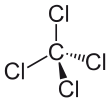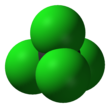
Back Tetrachloormetaan Afrikaans رباعي كلوريد الكربون Arabic Tetraxlormetan Azerbaijani کربون تتراکولورید AZB Тетрахлорметан Bulgarian কার্বন টেট্রাক্লোরাইড Bengali/Bangla Tetraclorur de carboni Catalan Tetrachlormethan Czech Tetraklorkulstof Danish Tetrachlormethan German
| |||

| |||
| Names | |||
|---|---|---|---|
| IUPAC name
Carbon tetrachloride, Tetrachloromethane
| |||
| Other names
Benzinoform, Carbon chloride, Carbon tet, Freon-10, Refrigerant-10, Halon-104, Methane tetrachloride, Methyl tetrachloride, Necatorina, Perchloromethane, Tetraform, Tetrasol
| |||
| Identifiers | |||
3D model (JSmol)
|
|||
| ChEBI | |||
| ChEMBL | |||
| ChemSpider | |||
| ECHA InfoCard | 100.000.239 | ||
| EC Number |
| ||
| KEGG | |||
PubChem CID
|
|||
| RTECS number |
| ||
| UNII | |||
| UN number | 1846 | ||
CompTox Dashboard (EPA)
|
|||
| |||
| Properties | |||
| CCl4 | |||
| Molar mass | 153.81 g·mol−1 | ||
| Appearance | colourless liquid | ||
| Odor | Sweet, chloroform-like odor | ||
| Density | 1.5867 g cm−3 (liquid) 1.831 g cm−3 at −186 °C (solid) | ||
| Melting point | −22.92 °C (−9.26 °F; 250.23 K) | ||
| Boiling point | 76.72 °C (170.10 °F; 349.87 K) | ||
| 0.097 g/100 mL (0 °C) 0.081 g/100 mL (25 °C) | |||
| Solubility | soluble in alcohol, ether, chloroform, benzene, naphtha, CS2, formic acid | ||
| log P | 2.64 | ||
| Vapor pressure | 11.94 kPa at 20 °C | ||
| kH | 2.76x10−2 atm-cu m/mol | ||
| -66.60·10−6 cm3/mol | |||
Refractive index (nD)
|
1.4607 | ||
| 0 D | |||
| Structure | |||
| Monoclinic | |||
| Tetragonal | |||
| Tetrahedral | |||
| 0 D | |||
| Thermochemistry | |||
| Std enthalpy of formation ΔfH |
-139.3 kJ/mol | ||
| Standard molar entropy S |
214.42 J/mol K | ||
| Specific heat capacity, C | 132.6 J/mol K | ||
| Hazards | |||
| EU classification | |||
| NFPA 704 |
| ||
| R-phrases | R23/24/25, R40, R48/23, R59, R52/53 | ||
| S-phrases | (S1/2), S23, S36/37, S45, S59, S61 | ||
| Flash point | <982°C | ||
| U.S. Permissible exposure limit (PEL) |
TWA 10 ppm C 25 ppm 200 ppm (5-minute maximum peak in any 4 hours)[1] | ||
| Related compounds | |||
| Other cations | {{{value}}} | ||
| Related {{{label}}} | {{{value}}} | ||
| Related compounds | {{{value}}} | ||
Except where otherwise noted, data are given for materials in their standard state (at 25 °C [77 °F], 100 kPa). | |||
| Infobox references | |||
Carbon tetrachloride, also known as tetrachloromethane or carbon tet for short, is a chemical compound. Its chemical formula is CCl4. It contains carbon in its +4 oxidation state and chloride ions. It is a colourless heavy liquid.
- ↑ NIOSH Pocket Guide to Chemical Hazards. "#0107". National Institute for Occupational Safety and Health (NIOSH).


